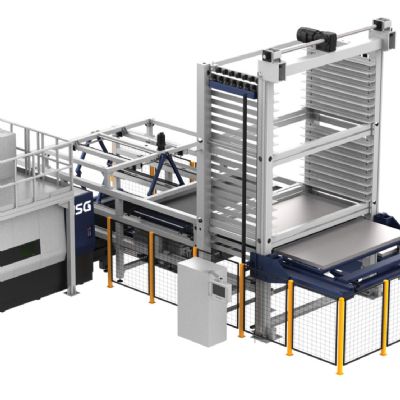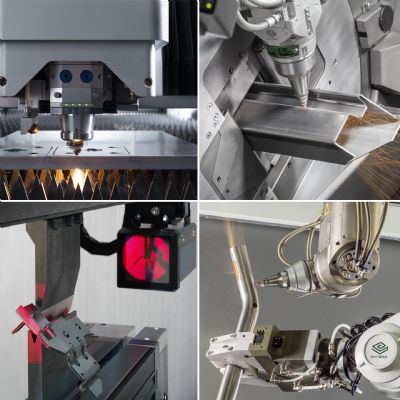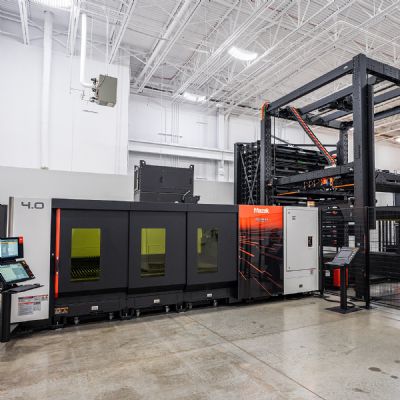New Laser Cutting Technology Needed
In 1992, beside the purchase of an SLA 500 rapid prototyping machine, 3-Dimensional Services agreed to house nearly a dozen NTC CO2 laser cutting machines in its nearly empty building for demonstration purposes—very early in the evolution of laser cutting technology. Not afraid of existing on the leading edge of technology, 3-Dimensional Services gained experience and expertise on these machines, and soon would buy them all for internal use.
The company has remained constantly on the lookout for more forming and fabrication equipment as work continues to build. A big part of that: the growth of projects from prototypes to initial runs, and periodic ups in the volume needs from customers.
“When a customer looks for a new automotive seat assembly, for example,” Peterson says, “we may start with 20 prototype seats, which is a fair amount of work starting from scratch. Then, the customer might say, ‘we need 100,’ and we’ll make those. Then the customer needs 1200, then 1800. Quite often, volumes start off low, and then build. It’s a little tricky making lower volumes knowing that you might have to make thousands and thousands. Some of our programs extend to 50,000 assemblies and beyond, so we must always be ready to produce more as needed.”
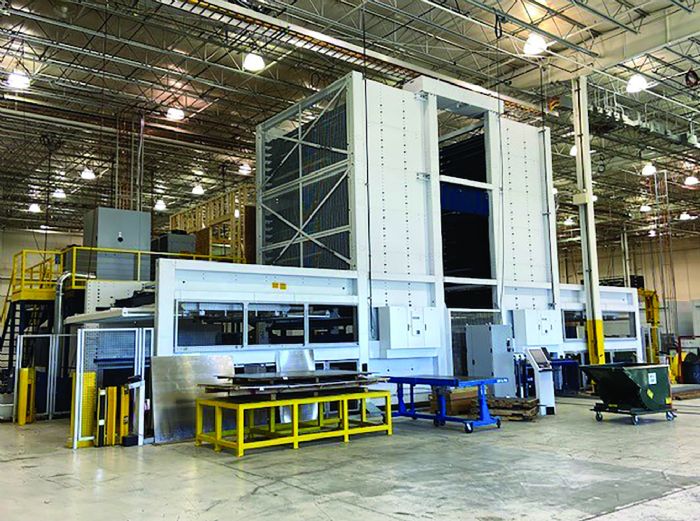 This business reality spurred 3-Dimensional Services, in 2013, according to Peterson, to search the world for fiber laser cutting technology, which promised higher speeds, thus greater productivity.
This business reality spurred 3-Dimensional Services, in 2013, according to Peterson, to search the world for fiber laser cutting technology, which promised higher speeds, thus greater productivity.
“We bought a flat-sheet laser cutting machine from Trumpf, a 3-kW TruLaser 2030 fiber with a 5 by 10-ft. bed, which dramatically increased our cutting speeds, to five times what we had, and the same amount of volume gains,” he recalls. “We saw the demos and thought, ‘that’s great,’ but to see the fiber laser cutting machines match the demos during production, holy cow!”
With jobs coming and coming, 3-Dimensional Services invested in more Trumpf machines, using them not only to cut steel but aluminum as well—at high speeds and with high quality.
“We can cut aluminum with CO2 laser machines, but the edges are a bit ragged,” Peterson says. “The fiber laser cutting machines, on the other hand, just eat aluminum and leave beautiful finishes. And, CO2 machines struggle with copper, but not the fiber laser machines.”
Getting jobs out quicker meant the need to get more work, which meant the need for more machines.
“So we’d buy the fourth, then the fifth…it just keeps going,” says Peterson. “That’s what happened with Trumpf—we searched the world for machines, and we keep doing that, but the Trumpf machines work all day every day, and Trumpf comes out to conduct training, which is excellent.”
Five-Axis Binge
With multiple Trumpf flat-sheet fiber laser machines inhouse, Peterson and the 3-Dimensional Services team decided, in 2015, that it needed to get into five-axis fiber laser machines, and did it ever.
As of May 2022, the company claims 19 Trumpf five-axis fiber laser cutting machines, along with six Trumpf flat-sheet fiber machines, including 3- to 5-kW TruLaser 2030, 3040 and 5040 models. Rochester Hills houses five of the five-axis machines and three of the flat-sheet cutters, with the rest in Lapeer. Also, the company counts five Trumpf machines among its 23 press brakes, with two Trumpf TruBend 7050 brakes set for install by year’s end.
And, expected to be completed by press time: installation in Lapeer of two more Trumpf 12-kW TruLaser 5040 fiber flat-sheet machines, each with Trumpf TruStore compact storage and material handling units, joining an existing machine, also with a TruStore package.
“We cut a lot of 3-mm-thick steel, and these machines cut at 1400 in./min.,” Peterson says of the 12-kW cutters. “The first time I saw one of these machines, it was cutting holes 10 ft. away, and it traveled back toward me so quickly that I jumped back away from the window.”
Together, 3-Dimensional Services’ stamping and laser cutting equipment serve each other’s needs, according to Peterson.
“We might laser cut a steel or aluminum flat blank,” he explains, “then take it to a press, and then stamp it but without holes or trimming. Then we’ll take that part to a five-axis laser cutting machine for the holes and trim work. Then that finished stamping might end up in a subassembly or final assembly. The five-axis fiber laser cutting for these parts takes only about 2 min.—not as fast as flat-sheet cutting, but older technology would take 7 or 8 min. On this work the five-axis fiber laser cutting gives us huge productivity gains.”
Adding to these gains: use of large 17.5-ft. rotating tables that allow operators to load and unload parts while a series of five new Trumpf TruLaser Cell 7040 6-kW five-axis machines cut. Further efficiencies result from the company’s placement of raw material very close to the flat-sheet fiber laser cutting machines.
The company still employs a half dozen of the NTC CO2 machines for support.
“A low-quantity job using thin steel, especially if we're busy on the on the fiber laser cutting machines, will be sent to the CO2 machines for cutting,” Peterson says.
New to the product mix for the five-axis machines: cutting of holes and features into aluminum extrusions.
Keeping all of the laser cutting equipment fed are Linde Gas high-capacity gas-storage systems—such infrastructure proves a must as 3-Dimensional Systems constantly adds to its equipment roster. And, expect the additions to continue as the company seeks to keep adding work.
“For every job we have to bid against three or four competitors—no one just hands us work—so we stay aggressive,” Peterson concludes. “We’re a hunting dog, not a lap dog.” MF
View Glossary of Metalforming Terms
See also: TRUMPF Inc., 3-Dimensional Services Group
Technologies: Cutting







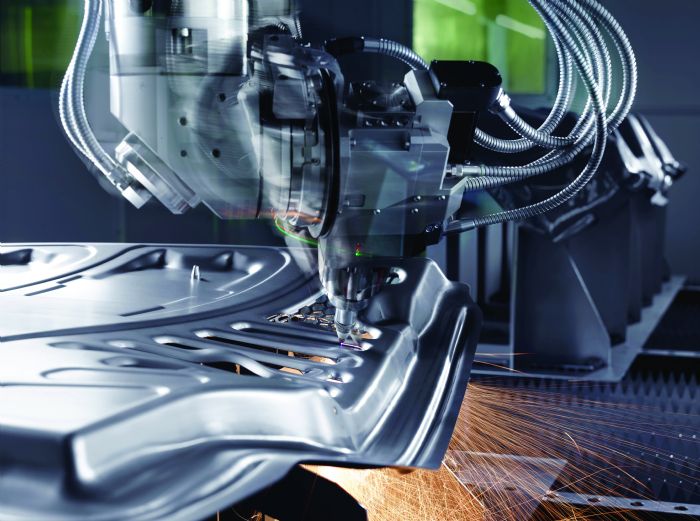 Back in 1992, founder Doug Peterson, with his five coworkers, set out to build a design engineering and prototyping company in a 27,000-sq.-ft. facility. Right away, the 1994 FIFA World Cup soccer tournament provided a huge opportunity. FIFA had awarded the United States the World Cup tournament for 1994, with nine locations across the country were selected to host matches, including the Pontiac Silverdome in Pontiac, MI.
Back in 1992, founder Doug Peterson, with his five coworkers, set out to build a design engineering and prototyping company in a 27,000-sq.-ft. facility. Right away, the 1994 FIFA World Cup soccer tournament provided a huge opportunity. FIFA had awarded the United States the World Cup tournament for 1994, with nine locations across the country were selected to host matches, including the Pontiac Silverdome in Pontiac, MI.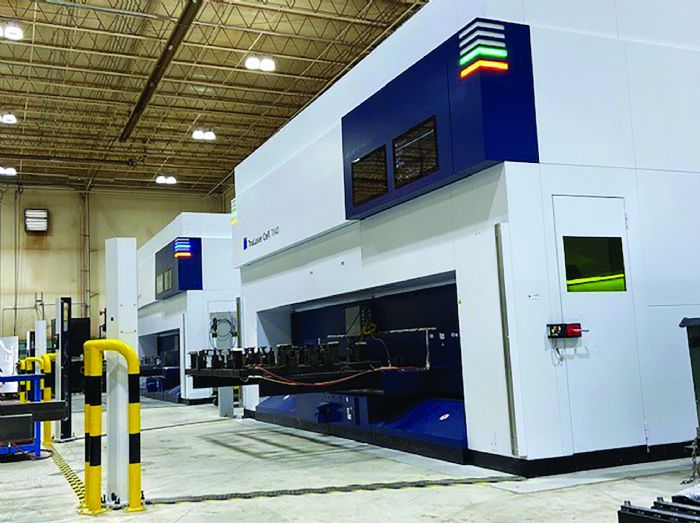 Peterson and his team, using its rapid prototyping capabilities, constructed a small hexagonal-frame corner of a soccer field and the company’s presentation to the selection team won it the job. Now the small company had to figure out how to deliver on the $1 million-plus contract. Deliver it did, and 3-Dimensional Services, with the successful turf-box system under its belt, was on its way. In 1994, on that turf-box system, the United States played Switzerland in the first-ever indoor World Cup match.
Peterson and his team, using its rapid prototyping capabilities, constructed a small hexagonal-frame corner of a soccer field and the company’s presentation to the selection team won it the job. Now the small company had to figure out how to deliver on the $1 million-plus contract. Deliver it did, and 3-Dimensional Services, with the successful turf-box system under its belt, was on its way. In 1994, on that turf-box system, the United States played Switzerland in the first-ever indoor World Cup match.